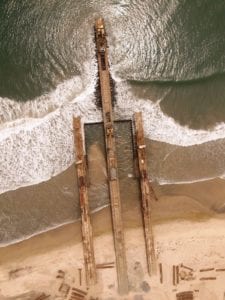Photo: An aerial view of the temporary works
Frankipile Ghana, a division of Esorfranki Geotechnical, is progressing well on the urgent Ada Coastal Protection Works project launched by Ghana’s Ministry for Works and Housing to reduce coastal erosion along the Ada Foah coastline, protect local industries such as fishing and tourism, and prevent or retard the silting up of the river delta. Ada Foah is some 100 km east of Accra near the Volta River estuary that flows into the Atlantic Ocean. Conditions, constantly in flux, and exacerbated by waves reaching heights of 20 metres, were particularly challenging, with the ground profile below sea level consisting generally of sands interbedded with layers of silts and clays of varying proportions and consistency. Design and supervision of the project are being undertaken by International Marine & Dredging Consultants (IMDC) with Dredging International (DI) acting as the main contractor. Seven rock groynes varying in length from 100 to 200 metres will be constructed perpendicular to the shoreline over a distance of approximately 4.7 km west from the Volta river mouth. Frankipile Ghana is responsible for the temporary works including the main and support jetties and the cofferdams. Garry Boyd, work director of Esorfranki Geotechnical says the company was able to draw on over 66 years of experience in geotechnical and marine work to design a customised and comprehensive geotechnical solution for this demanding and complex project. “Starting in June 2012, which was the season of the highest waves, we have a 12-month deadline to complete the project,” Boyd continues. “It represents the biggest we have undertaken in Ghana to date. We first designed and implemented the temporary works necessary to construct the offshore rock groynes, building one main jetty for the placement of the rock material, ranging in mass from 300 kg to 10 000 kg, for the full length of each groyne. These temporary works will total approximately 2.5 linear kilometres of jetties and 1.5 linear kilometres of sheet piles with a total contract value of about ten million Euros. “A sheet pile cofferdam was necessary to ensure that we could control the placement of material near and on-shore, and we built this using two support jetties.” Dr Nicol Chang, senior design Engineer in Esorfranki’s ISO 9001 accredited in-house design department, explains that these jetties were designed to cater for vertical and lateral forces from the 100 tonne CAT C385 excavator used by DI to place armour rocks of up to 10 tonnes, as well as for the dynamic forces from breaking waves.“We also used combined wave and excavator loading to establish safe operational conditions for the cranes and excavators on the jetties. The volatile seabed conditions required us to model standard solutions for the conditions that prevailed at the actual time of construction of the temporary works for each groyne.”
The design also had to cater for scour around the sheet pile cofferdam and the tube piles, ensuring that scour conditions are monitored daily. “We had to take into account the corrosion of the tube piles which is critical to their bending resistance, so we also monitor corrosion rates after each use of the tube piles themselves,” Chang continues. The temporary structure as a whole was designed for annual wave conditions with sea levels shallower than 2.5 metres for the cofferdams and support jetties and 5.5 metres for the main jetties. Steel tube piles vibrated into the seabed with a hydraulic vibratory hammer hanging from NCK C75 or Liebherr H5845 cranes support the main and support jetties. A similar method is used to install sheet piles for the cofferdam, with the cranes operating off the two support jetties. Two purpose-made 40 tonne bogies supply materials along the jetties. The difficulty of the work was intensified by the impact of the often 20 metre high waves which frequently damaged the wooden decks between the main beams of the jetties, causing delays during construction of jetties at the first groynes. “The sequence of work was revised to work on two groynes simultaneously, with the materials on the returning groyne used on the advancing groyne,” Boyd points out “This significantly reduced standing time of the equipment while material placement was taking place on the returning groyne.” He adds that all the equipment necessary for the successful completion of the project is sourced from Esorfranki Geotechnical’s extensive in-house plant base. “This project promotes Esorfranki’s corporate strategic objective of expanding its footprint in Africa, exploring sustainable growth opportunities on the continent where our expertise can work to the benefit of projects that focus on mineral resources and marine infrastructure. It builds on the platform created by our first successful project in Ghana in 2011.”







